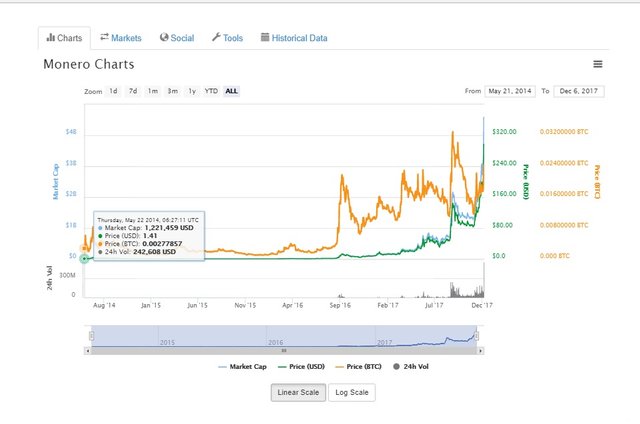MONERO ANALYSIS AND REVIEW: MAINTAINING PRIVACY IN THE WORLD OF DECENTRALISED BLOCKCHAINS
With blockchain technology slowly gaining attention from mainstream business, especially given the skyrocketing prices of Bitcoin, it is only a matter of time before blockchain and cryptocurrency gains mass adoption.
Of course, it is expected that not every player in this space today will survive 5 years from now. For all you know, the king of the cryptocurrency world, Bitcoin, might even make way for faster, more efficient cryptocurrencies that do not require the substantial miners’ fee needed by Bitcoin today, the enormous processing power required to mine blocks, or even the time required for processing transactions on Bitcoin’s blockchain network (Litecoin anyone?).
While Bitcoin has been hogging most of the limelight in media circles (and rightly so, given its market capitalisation), countless other cryptocurrencies have been on the rise and some of these provide unique solutions in the world of blockchain that are not addressed by the granddaddy of cryptocurrencies.
One such player that’s been steadily on the rise oblivious to many is the cryptocurrency Monero – the 10th largest cryptocurrency as of today.
Monero has been lurking in the shadows gaining far less attention than even coins such as NEO, OMG or Lisk, that have far less market capital, but are favourites among newcomers in the world of cryptocurrencies. If you are somebody who has been dabbling in cryptocurrencies for a while without paying attention to Monero, then maybe it’s about time you did because Monero is unique in a way that none of the coins we mentioned earlier are.
So what makes Monero different from other major cryptocurrencies?
The answer in one line is that it provides genuine privacy and is virtually untraceable.
Those who understand Bitcoin or Ethereum would know that the addresses storing bitcoins or ethers are completely transparent – they are on open ledgers. In other words, if you own an address on the Bitcoin (or Ethereum) blockchain, anybody who knows the address can simply see details of ever transaction that’s ever been made on that address. This includes the number of coins/tokens that address holds, where that address has received coins from (and how many), and to which address it has sent coins (and how many) too.
That’s as transparent as it gets. Also, given that the Bitcoin network is a peer-to-peer network, it is possible to listen for transactions' relays and log their IP addresses.
Therefore, while Bitcoin/Ether do give a feeling of anonymity since these blockchains don’t reveal the users who own their addresses, these addresses are not completely private and somebody (government?) with enough resources wouldn’t find it too difficult to trace the source of coins to actual owners by picking up the trail using their transaction breadcrumbs.
Now, in the case of Monero, the story is completely different.
While Monero also uses a public ledger to record transactions and create new units through mining, it improvises on existing bitcoin design by obscuring the sender, the recipient and amount associated with transactions. Monero’s 3-pronged way of privacy protection today that includes the usage of ring signatures, stealth addresses, and RingCT (that hides transaction amounts) makes it an opaque blockchain unlike the transparent ones like Bitcoin and Ethereum.
For the record, Monero uses the CryptoNote protocol whose transactions on the blockchain can’t be traced to find senders or receivers. The approximate amount of a transaction happening on the network can be known, but the origin, destination, or actual amount can’t be found. In this network, the only people with access to the whole set of data about a transaction are the sender or receiver of the transaction and the person who possesses one or both secret keys.
Monero’s developers haven’t stopped with what they have achieved too on the privacy front. They are now also building a decentralized, anonymity technology called Kovri. Kovri is technology based on I2P’s (This is an anonymous peer-to-peer distributed communication layer) open specifications. Kovri uses something called garlic encryption and routing to create a private, protected overlay-network across the internet. What this means for users is that they can effectively hide both their geographical location and IP address when transacting too. By today’s standards, this is as discrete as network transactions get when dealing with cryptos.
An added benefit of Monero - Spendable in real world via Debit Cards
Monero was among the first companies to provide their own custom debit cards for enabling real world spending of crypto-currencies (TenX nowadays provides a much wider option of multi-crypto payment though). This means your faceless cryptos could be spent in the real world too.
Monero’s growth rate
Between 22nd May 2014 and today, Monero has climbed from $1.47 to $296 - that's a climb of over 20,000% (twenty thousand percent, no error in the number of zeroes there) in a little over 3.5 years!
Monero’s market capital has also gone up from $2000 to $3.1 Billion (currently #10 in overall market cap) in this period!
Other things you must know is that Monero is the #1 privacy coin by a long margin and it's one of the only handful of coins that has stayed in the top 15 market cap for more than 2 years consistently – this shows that it’s positioning today is not a fluke or a planned pump that could deflate one fine day and it has a huge first mover advantage in the privacy space.
What is the problem Monero could potentially face in the future?
With a combination of CryptoNote and Kovri, Monero will effectively be creating the ultimate level of anonymity in digital transactions yet.
Now, while this is a boon for genuine users who don’t want anybody snooping into their digital assets and becoming a target for nefarious phishers or digital thieves, it could also pose another huge risk – it can be used for transactions by criminal enterprises!
Bitcoin and Ether are anonymous on a surface level but with enough resources and some effort, government agencies could arguably trace most of these back to their actual users (provided, of course, it’s worth the trouble). But with Monero, they would be left blind and groping in the dark. And that makes Monero not just powerful but also potentially dangerous and a serious threat to law enforcement.
Therefore, despite all its positives including stupendous growth, if serious crimes start getting linked with Monero someday, world over, government bodies could start targeting the currency. While governments may not be able to eradicate this decentralised currency completely, they might just provide a blanket ban on exchanges (there are over 50 today that trade Monero) that deal with the currency thereby cutting down on its liquidity which might just be a kill switch over the long run (‘might’ being the keyword here).
As an amateur observer, in all humility, I could be wrong and Monero’s team might come up with some other ingenious way of surviving – these are things only time can tell so let’s talk about crossing that bridge when we reach it.
Till then, Monero will chug on like a goods train – slow, steady, and immensely powerful, but oblivious, unlike the far more visible passenger ones.
How to buy Monero?
Monero (XMR) is listed on multiple exchanges. BharataFinace (one of the most popular Indian Crypto communities) lists the best exchanges below so that you can buy from any of them:
Disclaimer: Opinions expressed in this article are solely that of the author and is provided for educational purposes only. This is by no means meant as any investment advice to those looking to invest in cryptocurrencies – those looking to cryptocurrencies are advised to do their own research and make decision calls accordingly.
About the author: Roji Abraham is a Crypto and stock markets enthusiast, Project Manager, and the author of 4 books, including the #1 Amazon Global Bestseller ‘The Ultimate Options Trading Strategy Guide for Beginners’. You can follow him on Steemit
This article was originally published by the author on BharathaFinance.com : https://bharatafinance.com/monero-analysis-privacy-coin/
.jpg)

nice article @roji.abraham! Keep up the good work !
Thanks for reading @jedigeiss
This post has received a 0.83 % upvote from @buildawhale thanks to: @roji.abraham. Send at least 1 SBD to @buildawhale with a post link in the memo field for a portion of the next vote.
To support our daily curation initiative, please vote on my owner, @themarkymark, as a Steem Witness
This post has received gratitude of 0.61 % from @appreciator thanks to: @roji.abraham.